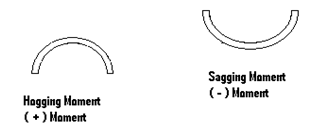Hogging and Sagging | Definition, Difference and Applications of Sagging and Hogging Moments
Hogging and Sagging | Difference Between Sagging and Hogging Bending Moments | Causes Sagging and Hogging Bending Moments In Ship | Negative and Positive Bending Moments
What is Hogging and Sagging?
Hogging and sagging are terms used in solid mechanics, structural engineering, and shipbuilding to describe the shape that a beam or similar long item will deform into when loaded.
Hogging is a term used to describe a beam that curves upwards in the center, whereas sagging is used to describe a beam that curves downwards.
Sagging and Hogging Bending Moments
Shear force can be exerted in two directions: upward and downward. Moments are classified into two types, similar to how axial force can be applied as compressive or tensile force.
The first is a hogging moment, while the second is a sagging moment.
Sagging Moment
The moment that causes a beam to concave upward is referred to as the sagging moment. It is often regarded as a favorable occurrence.
At this point, the upward beam compresses and the lower beam extends. As a result, stresses known as bending stress arise.
Hogging Moments
Hogging moment is the instant that causes a beam to concave downward. It is regarded as a negative event.
The upward point is under stress, whereas the downward point is under tension.
There is a line along the axial direction that is neither compressed nor tensed. It is known as the neutral axis.
The locations below the neutral axis are under tension in the sagging moment and under compression in the hogging moment, and vice versa in the following situation.
What is the Difference Between Sagging and Hogging Bending Moments?
The terms sagging and hogging are used to describe the sign of a bending moment.
A Sagging Bending Moment is the bending moment that causes a beam to bend with the concave side upwards. This bending moment is referred to as a positive bending moment.
A Hogging Bending Moment, on the other hand, is the bending moment that causes a beam to bend with the concave side downwards. This type of bending moment is known as a negative bending moment.
What force causes hogging sagging bend moments?
Sagging and Hogging Bending Moments in Ship
Hogging is the tension that a ship’s hull or keel bears, causing the center or keel to bow upward. Hogging, often known as “hog,” is a semi-permanent bend in the keel created over time by the ship’s center being more buoyant than the bow or stern.
Sagging refers to the stress imposed on a ship’s hull or keel when a wave is the same length as the ship and the ship is in the trough of two waves.
This causes the ship’s center to bend slightly downward, which, depending on the degree of bend, may cause the hull to fracture or crack.
What Causes Sagging and Hogging Bending Moments
If the ship is subjected to localised loading at the fore and after ends, for example ship with machinery aft and in light condition with ballasted fore peak tank, the hull would tend to ‘hog.’
This effect would be exacerbated if the wave crest was located amidships and had a wavelength comparable to the ship’s length.
Sagging occurs when the load and buoyancy distribution tend to distort the hull, for example, a ship with machinery amidships in light conditions.
This is exacerbated when the wave crests are at the ship’s ends and have a wavelength comparable to the ship’s length.
How to stop/prevent sagging and hogging ships
Preventing hogging and sagging can be done by having the following structural members; Keel, floor timber and hog piece.
The keel is the primary fore and after member of a boat, constituting the backbone of the structure and aiding in the prevention of hogging and sagging.
A hog piece (or keel batten) is a flat timber element affixed to the keel to form a T-section that supports the garboard planking and prevents hogging and sagging.
Floor timbers are transverse wooden components that cross the keel and are bolted to the lower end of a frame as well as the keel.
Plank fasteners are typically pushed or screwed into floor timbers. Floors ties the ship’s bottom to the keel and help to keep the ship’s bottom from sagging.
Sagging and Hogging Bending Moments in Structural Beams
The sagging of beams is referred to as “deflection” in the construction industry. The degree of deflection varies depending on the stiffness of the beam, the span between supports, and the weight it carries. In older homes, sagging is a common occurrence.
When a continuous frame is loaded, it generates a series of positive and negative moments in the beams; the moments on the top faces near the joints/supports are known as hogging moments, while the moments in the center bottom region of the beams are known as sagging moments.
What is the distinction between negative and positive bending moments?
Positive bending moment is defined as tension on the bottom side of the beam or compression on the top side of the beam.
For example, consider a simply supported beam loaded with self-weight, with zero bending moments at the support sections and maximal positive bending moments in the intermediate section. This is also known as a sagging moment.
Bending moments at support locations will be negative if the beam is continuous and supported by multiple equally spaced supports.
As a result, near the support area, tension is at the top and compression is at the bottom of the beam. This is also known as a hogging moment.
